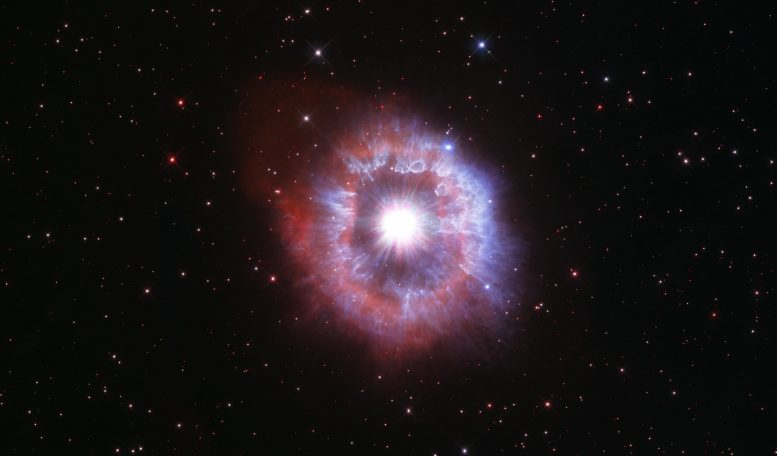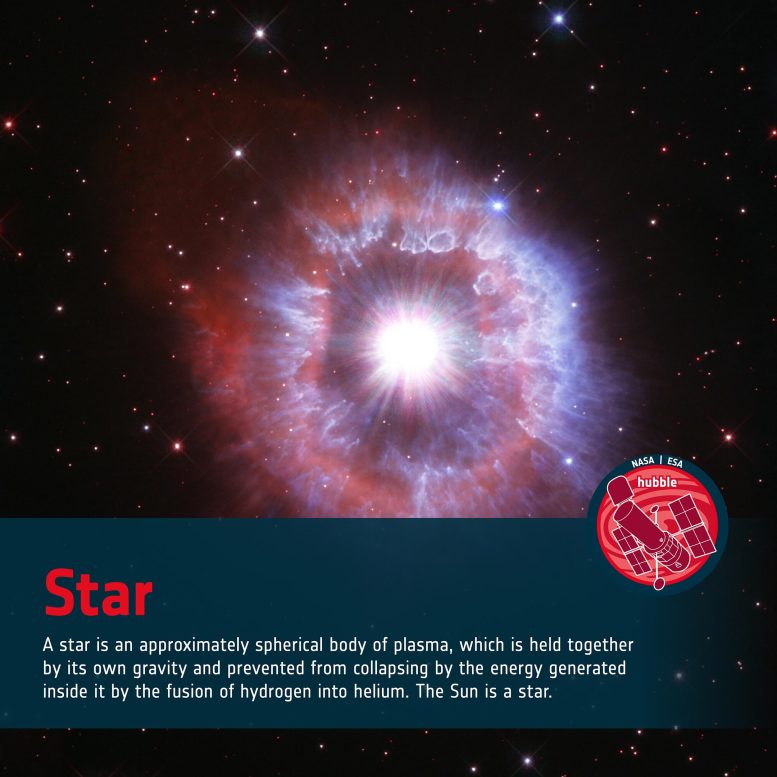
What Is a Star?
A star is an approximately spherical body of plasma, which is held together by its own gravity and prevented from collapsing by the energy generated inside it by the fusion of hydrogen into helium. The Sun is a star.
Stars form from clouds of dust and gas. Like planets, stars accrete sufficient mass to assume a spherical shape, held together by their own gravity. Unlike planets, stars eventually generate sufficient pressure and temperature at their core for hydrogen fusion to begin. Hydrogen fusion is the process whereby hydrogen is transformed into helium, in a thermonuclear process that releases energy. The energy released from fusion prevents stars from collapsing under their own gravity, and so the stable lifetime of a star is bounded by how much hydrogen it has available for fusion. Stars have so much energy that their constituent elements are in the plasma phase — a phase of matter where atoms and molecules are stripped of at least one of their electrons, and the electrons can roam freely.
Stars vary hugely in size, longevity and temperature. The more massive a star is, the hotter it is and the more quickly it will burn through its hydrogen and die. For this reason, massive stars are said to ‘live fast and die young’. Stars are classified according to their temperature, which can be determined by scientists because a star’s apparent color depends on its surface temperature. The classification is: O, B, A, F, G, K and M. O-type stars are the hottest and the bluest, and M-type stars are the coolest and the reddest. Our Sun is a G-type star, and its apparent color is a yellowish white.
A star is an approximately spherical body of plasma, which is held together by its own gravity and prevented from collapsing by the energy generated inside it by the fusion of hydrogen into helium. The Sun is a star.
Most of the light and radiation we can observe in the Universe originates in stars — individual stars, clusters of stars, nebulae lit by stars and galaxies composed of billions of stars. Like human beings, stars are born, mature and eventually die, but their lifetimes span millions of years. Hubble has gone beyond what can be achieved by other observatories by observing the births, lives and deaths of individual stars and refining theories of stellar evolution.
In particular, Hubble’s ability to probe stars in other galaxies enables scientists to investigate the influence of different environments on the lives of stars. This is crucial in order to be able to complement our understanding of our own Milky Way galaxy with an understanding of other galaxies. Another area where Hubble’s work has been widely acknowledged is the observations of star forming regions, as Hubble’s infrared instruments, WFC3 and NICMOS, are capable of looking through the dust clouds that surround newly born stars.

Some of the most surprising discoveries so far have come about by peering through the clouds of dust surrounding the center of our Milky Way. Using Hubble, astronomers have found that this region, which was thought to be calm and almost ‘dead’, is in fact populated with massive infant stars gathered into clusters.
Hubble is also able to offer sharper visible-light images than any telescope currently in operation on the ground. This means that it is well suited to studying stars in nearby galaxies. Whilst most galaxies cannot be resolved into the individual stars they are made up of, the Milky Way’s neighbors, including the Magellanic Clouds and the Andromeda Galaxy (also known as M 31), the closest spiral galaxy to the Milky Way, can now be broken down into hundreds of millions of individual points of light, and their stars studied individually. Hubble has even been able to resolve star clusters in the Andromeda Galaxy, despite its being around 2 million light-years away. It has also discovered that the stars in the halo (the sparse region around a galaxy’s disc) of M 31 are significantly younger than those of the Milky Way.
1 Comment
What, “Our Sun is a G-type star, and its apparent color is a yellowish white.” only if you are looking though a BLUE filter like the Earth’s sky !!!